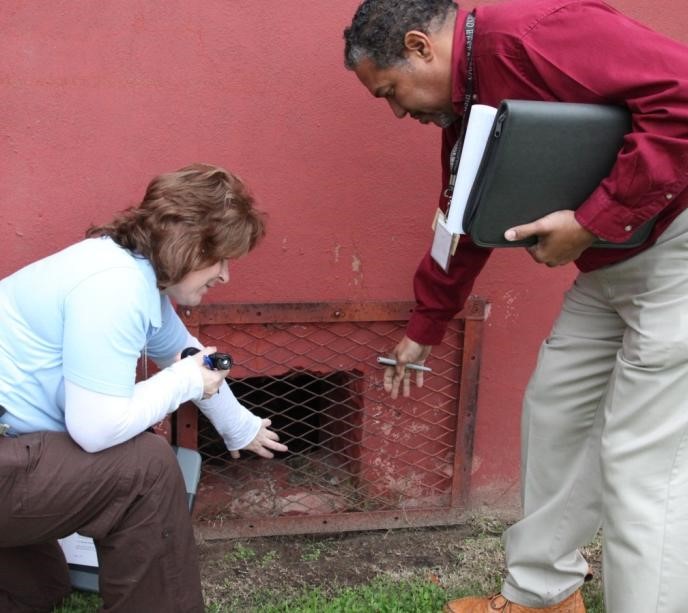IN THIS ISSUE
|
|
|
"Smart, Sensible and Sustainable Steps"
These easy IPM steps can make a big impact on your school environment:
- Install door sweeps. If you can see light under a door, pests can enter under that door. Not only will door sweeps prevent pests, but they can reduce heating and cooling costs!
- Repair leaky pipes and seals. Repairing leaks will take away drinking water and breeding areas for pests, can reduce asthma-triggering mold and can lower water bills!
- Keep food in sealed containers. This will keep pests out while preserving freshness and reducing unpleasant food odors!
- Make sure all garbage cans have tight-fitting lids. Keep smells in and pests out!
- Organize a community weed-pulling event at school for students and parents. Build community while having fun and reducing the need for herbicide use!
|
Access Previous Connector E-Newsletters Online
Can't find a previous IAQ Tools for Schools Connector e-newsletter in your inbox? No problem! Visit the e-newsletter archive on the IAQ Tools for Schools website to access printable versions (PDFs) of all past editions. |
|
- Clean Air Excellence Awards – Apply NowThe deadline to submit an application for the 2015 Clean Air Excellence Awards is fast approaching–September 12th! EPA will recognize innovative and replicable programs, projects, and technologies that directly or indirectly work to reduce emissions of criteria pollutants, hazardous air pollutants, and greenhouse gases (GHG). These projects could involve renewable energy, energy efficiency, combined heat and power (CHP), transportation and efficiency, and/or indoor air quality. To apply:http://www.epa.gov/air/cleanairawards/index.html
- New Moisture Control Guidance for Building Design, Construction and Maintenance is Available.EPA's Indoor Environments Division recently published new guidance to help school district professionals use state-of-the-art building techniques to control moisture throughout the life of the facility. Moisture problems in buildings can be controlled, and there are steps schools can take to make their buildings more moisture resilient. Download the guidance today:
http://epa.gov/indoorairplus/technical/moisture/index.html
- Attend the Council of Educational Facility Planners International (CEFPI), Annual Conference and Expo.
The conference – to be held October 3–6, 2014, in Portland, Oregon – brings together school district staff and industry representatives who are actively involved in planning, designing, building, equipping and maintaining school facilities. This year's conference features "America's Educator" Ron Clark, the winner of the 2000 Disney American Teacher of the Year award. Another session will highlight EPA's Indoor Environments Division new guide entitled Energy Savings + Health: Indoor Air Quality Guidelines for School Building Upgrades, as well as other EPA guidance and technical resources. Get more information on the CEFPI conference athttp://www.cefpirobustservices.org/websites/cefpi2014/index.php?p=134.
- Join the Center for Green Schools at the U.S. Green Building Council (USGBC) Green Apple Day of Service.
On September 2, 2014, thousands of volunteers in communities around the world will be showing their commitment to healthy, safe and productive schools through local acts of service. Events all over the globe are showing up on the Center's map. In its first two years, this annual event has seen more than 3,000 events take place in all 50 states and more than 40 countries. Consider registering an event or project that will improve your school's indoor environment, including classroom cleanups or a building walk-through using the IAQ Tools for Schools Action Kit checklists. Join today and register your event/project atwww.mygreenapple.org.
- Participate in the "School Community Mosquito Management via IPM" webinar.
This webinar – to be held on August 20, 2014, from 2:00 to 3:30 p.m. ET – will focus on mosquitoes: best practices for including mosquito management in your school integrated pest management (IPM) plan, pesticides for mosquito management and common biological methods for mosquito control. The webinar will feature national experts from Texas A&M University, American Mosquito Control Association and EPA. Register today at https://www1.gotomeeting.com/register/405236737

Integrated Pest Management in Your School
Rats. Cockroaches. Mosquitoes. Bed bugs. These pests, among many others, are harassing our nation's schools. How should schools address these issues in order to protect the health and safety of students and staff? How can your school work to provide an environment conducive to learning while striving to balance an often already-tight budget?
Pest management can be a drain on resources, but pests present real health risks, particularly to children. Cockroach and mice infestations may trigger asthma attacks and certain biting insects can transmit diseases.
What is your school currently doing to manage pests? Traditionally, schools rely on regular pesticide applications. While pesticides can be a useful tool in dealing with infestations, when used injudiciously they can be harmful to children's health and an ineffective use of resources.
Because children's health is a top priority, EPA recommends schools use integrated pest management (IPM) — a smart,sensible and sustainable method for controlling pests. IPM is smartbecause it reduces children's exposure to pests and pesticides;sensible because it promotes practical strategies that eliminate food sources and pathways that lead to infestations; sustainablebecause this prevention-based approach results in a 78-percent to 90-percent reduction in pest complaints with no long-term increases in costs. Make sure that your school is implementing the smart, sensible and sustainable solution that will protect children's health.
|  |
Why IPM Is Good for Your School
Schools that adopt an IPM program experience several benefits:
- Saved costs.
IPM is economically advantageous compared to traditional pest control because there are fewer pest complaints and pesticide applications. Additionally, IPM practices that prevent pests are energy- and water-saving practices as well. It also has been shown that the number of students reported absent due to asthma-related issues decreased. For more information check out "Saving Dollars and Making Sense: Keeping Bugs Out of the Classroom."http://www.epa.gov/pestwise/publications/ipm/School-IPM-Business-Case.pdf
- Minimized potential health risks to children and staff.Exposure to pests and inappropriately used pesticides places school occupants, especially children, at risk. An IPM program that makes areas uninhabitable for pests and uses pesticides judiciously reduces potential contact with pests and pesticides.
- Improved aesthetic quality of school and school grounds.Pests can detract from the overall environmental quality of a facility, which can, in turn, influence the way a school feels to its occupants. A clean, safe school environment promotes a positive learning environment.
Implementing IPM in Your School
In order to facilitate your school's long-term commitment to IPM, EPA recommends the implementation of an IPM policy. An IPM policy, if consistently used as a reference by school employees, can be a valuable tool for launching a sustainableIPM program in your district. For more information, check out "Model Pesticide Safety and IPM Guidance Policy for School Districts" http://www.epa.gov/pestwise/publications/ipm/Model-School-IPM-Policy.pdf. Stay tuned for a model contract that your school can use to hire a pest management professional who will provide quality IPM services!

Many school districts have already adopted an IPM program with measurable success!
Walla Walla School District. With only two groundskeepers, the Walla Walla district is successfully implementing an excellent IPM program at all 10 of its schools! The success of Walla Walla schools demonstrates that IPM practices can be implemented successfully with limited resources if staff are appropriately trained. http://www.ipminstitute.org/IPM_Star/ipmstar_profiles_wallawalla_wa.htm
 |
From left to right: Ken McPherson, EPA Region 6; Claudia Riegel, NOMTCB; Jim Jones, EPA Assistant Administrator, Office of Chemical Safety and Pollution Prevention; Janet Hurley, Texas AgriLife; Sherry Glick, EPA; Kimberley Pope, Louisiana State University
|
Get Answers to Your Questions
Is there a topic you want to see covered in an IAQ Tools for Schools Connector e-newsletter? Do you have suggestions for a webinar or e-newsletter feature, or do you have questions about a specific IAQ topic? If so, send us an email at IAQTfSConnector@cadmusgroup.com.
Share YOUR news and events! Send us information to share with the school IAQ community. It could be featured in the next Connector e-newsletter. Email your news and events to IAQTfSConnector@cadmusgroup.com.
The IAQ Tools for Schools guidance is a comprehensive resource designed to help schools maintain a healthy environment in school buildings by identifying, correcting and preventing IAQ problems. Learn more about the IAQ Tools for Schools guidance at http://www.epa.gov/iaq/schools. |
No comments:
Post a Comment